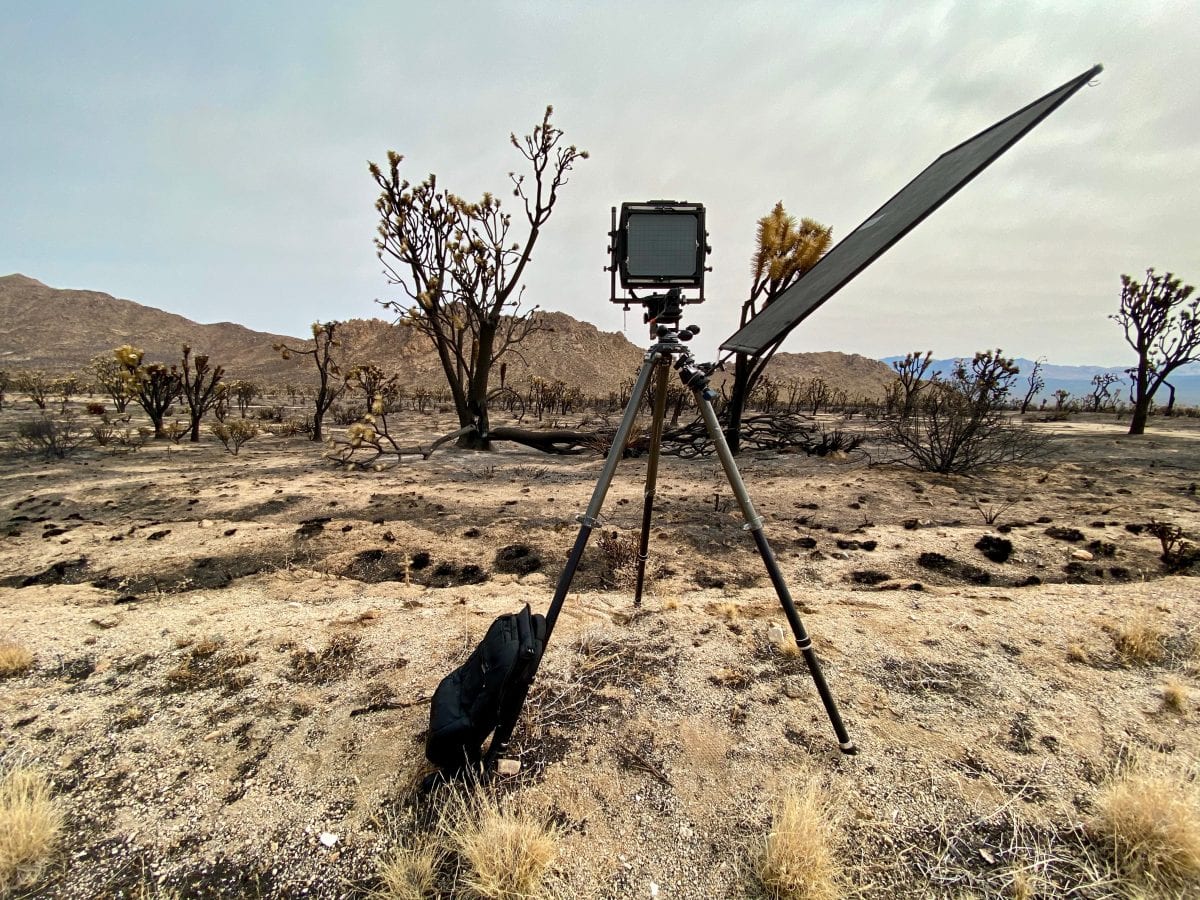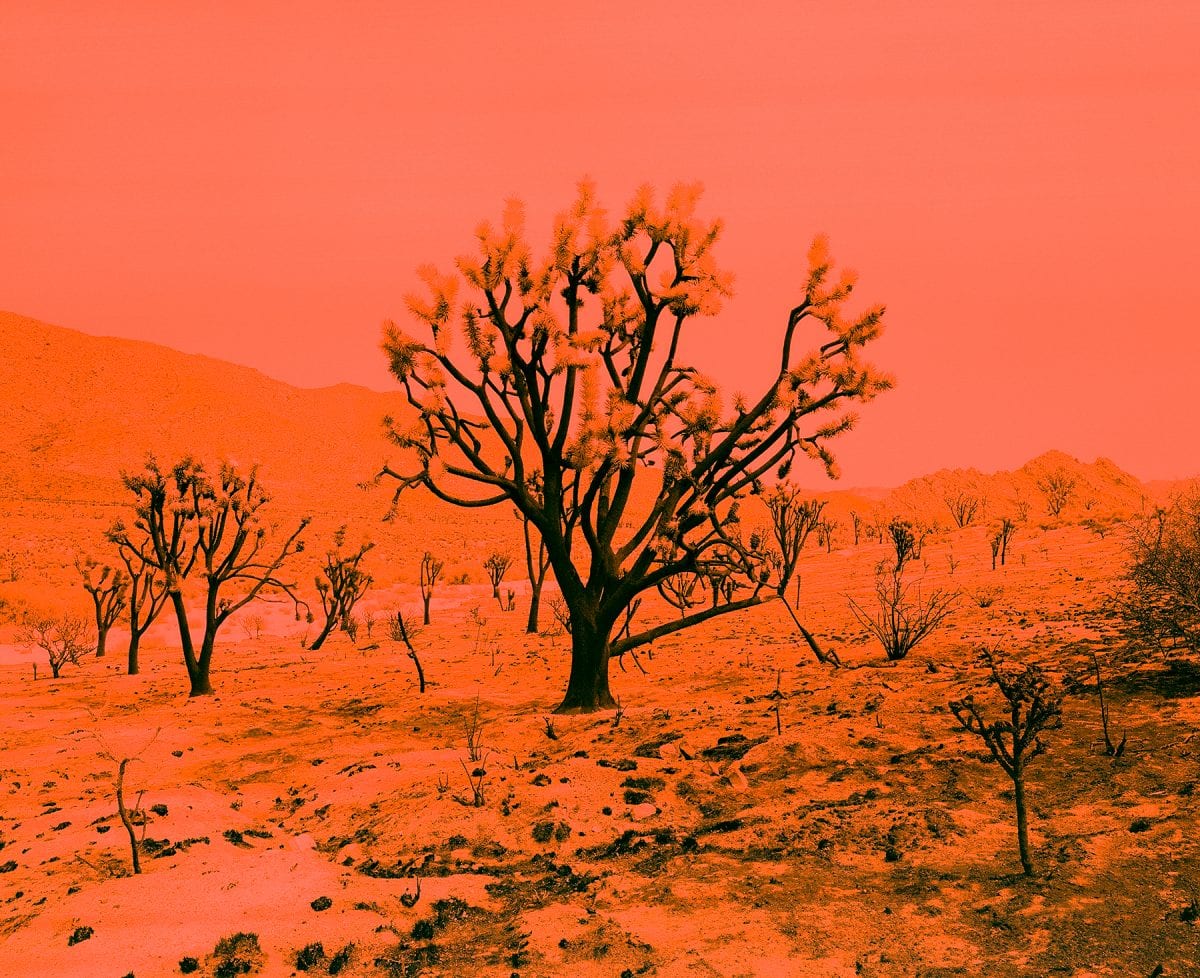The outstretched branches of the Joshua tree quiver with fiery spiky leaves and recede into the horizon. The single trunk that supports the once-thriving plant species still stands despite enduring intense heat and the unforgiving wrath of flames. Rainer Hosch’s documentation of the scorched earth in the aftermath of the Dome fire, just one of the wildfires that plagued California this year, captures a hauntingly beautiful and surreal moment. The Joshua tree personifies resilience as it remains rooted in the soil determined to thrive. The photographer’s latest work Apocalypse Now captured on a medium format camera depicts a landscape rising from the ashes. The photograph marks the beginning of a new series of landscapes and celebrates the launch of Hosch’s new print shop.
Where and when was Apocalypse Now captured?
In August 2020, during the lockdown in LA, I learned about the Dome fire, a wildfire that burned over 43,000 acres in the Cima Dome Joshua Tree Forest, located in the Mojave Nation Preserve. It is estimated that as many as 1.3 million Joshua trees were killed. I ventured out into the desert about two weeks after the fire, to document the impact.
How did you achieve the distinctive color of the landscape?
I normally capture about one to three exposures for each location I select. I was working on the last shot for the day and after completing the third exposure, I realized that there was one more frame remaining on the roll of 120 film. I considered changing the lens and when searching my bag I saw the red filter which is normally used for B&W film. I decided to give it a try for this one exposure on color film. Once I got the contact sheets from the lab I realized it worked out in a very special way.

How long did it take to set up the shot?
Once I select a certain area I spend about thirty minutes capturing different angels. For this project, I was also shooting an 8×10 film which slows down the process quite a bit, so I probably spent an hour on this shot. To capture the actual image only took 1/30 of a second on my camera.
Topanga Beach has been the primary subject of your fine artwork for the past two years. What was the experience transitioning from water to fire?
I have been looking for my next project for quite a while now. While the Topanga Beach project has a poetic approach that mostly ends with the sublime, I felt it was time to direct my attention to some of the issues of our time. With so many fires this year the choice became more and more clear and I started taking day trips into areas around LA that were affected by fires.

archival pigment print
16 x 20 in.
Artwork courtesy of Rainer Hosch
What message or mood do you hope to convey with Apocalypse Now?
The piece was originally selected to be part of the annual group show at Gallery Poulsen, which was also named Apocalypse Now. I intended it to be a graphic example of the problems involved with climate change and its impact on the environment. I also saw the image as looking toward hope as some of the trees will be able to recover over time. The image reminded me of what Henri Cartier-Bresson once said, “there is a poetry and a beauty in tragedy.”
What about the landscape inspired you to capture it?
I have been in love with the desert and the beach all my life. The contrast speaks to me. I find Joshua trees especially fascinating and they inspired my first trip to the Mojave Desert. I intend on continuing this series with different kinds of plants and trees in many different areas.
Apocalypse Now is the debut print on your new print shop. Why did you start with this print? What works can we look forward to seeing in the shop in the future?
I am very excited to open my new shop that features works that aren’t available anywhere else. The shop will be carefully curated with limited edition print runs, polaroids, and vintage prints tailored to fans of photography and popular culture. Apocalypse Now created an immediate visceral reaction among the first people I showed it to. I felt that it carried a powerful message and somewhat encapsulated the essence of all the challenges that 2020 brought to the world.
Featured Image Credit:
Rainer Hosch, “Apocalpyse Now,” 2020
archival pigment print
16 x 20 in.
(Detail View)
Image courtesy of Rainer Hosch
Installation Magazine ©2021
